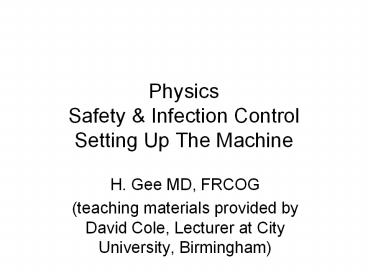Physics Safety - PowerPoint PPT Presentation
1 / 35
Title:
Physics Safety
Description:
The maximum change in pressure due to the soundwave Ultrasound Ultrasound High ... multiple reflectors Imaging Principles Imaging Principles How the image is ... – PowerPoint PPT presentation
Number of Views:88
Avg rating:3.0/5.0
Title: Physics Safety
1
PhysicsSafety Infection ControlSetting Up The
Machine
- H. Gee MD, FRCOG
- (teaching materials provided by David Cole,
Lecturer at City University, Birmingham)
2
Sound
WAVELENGTH ?
HIGH PRESSURE REGION
LOW PRESSURE REGION
ONE CYCLE
3
A sound wave
wavelength
Excess pressure
amplitude
4
Amplitude Frequency
- Frequency
- Pitch
- Amplitude
- Loudness
- the strength of the sound.
- The maximum change in pressure due to the
soundwave
5
Ultrasound
6
Ultrasound
- High Frequency Sound
- gt 20 KHz (above the audible range)
- Short Wavelength
- Resolution ? Wavelength
- 3.5 MHz - Wavelength .44 mm
- Frequency ? Penetration ?
7
Spatial Resolution
- The ability to display two small structures
situated close together as separate images
objects
Image resolved
Image unresolved
8
Piezo-electric effect
- Sound ? Electricity
Piezo-electric crystal
9
Inverse piezo-electric effect
- Electricity ? Sound
Piezo-electric crystal
10
Ultrasound transducer
PULSE
CONVERTS ELECTRICITY INTO SOUND
PIEZO ELECTRIC CRYSTAL
ECHO
CONVERTS SOUND INTO ELECTRICITY
11
Pulse echo techniquemultiple reflectors
12
Imaging Principles
13
Imaging Principles
14
How the image is produced
15
Summary
- Sound
- Ultrasound
- Piezo-electric effect
- Pulse-echo technique
- Imaging principles
- Resolution
16
Infection Control
17
Setting up the Machine
- Two Parts
- Monitor (may be done automatically)
- Contrast
- Brightness
- Grey Scale on Screen ALL GRADATIONS
- Imaging System
18
(No Transcript)
19
Equipment Controls
- Probe selection
- Mode selection 2D, Doppler, Colour
- Gain, TGC, Power
- Depth and Zoom Scan angle (field size)
- Focus
- Measurement, freeze
- (Examination selection post processing)
20
Probe selection
- This control is used to select from the probes
available - For example
- Curvilinear general
- Transvaginal
- Linear array for small parts
21
Mode selection 2D, Doppler, Colour
- 2D is normally selected automatically for all
examinations and the other modalities are
selected when required during the examination.
22
Making the image darker or brighter
- Power
- Gain,
- Time Gain Compensation
23
Safety
- Cavitation
- Heating
- Frequency
- Duration
- Intensity
- Power
24
Power (Output) increased
Safety implications Set power to 35 Use gain to
control brightness
BRIGHTER IMAGE
25
Power reduced
DARKER IMAGE
26
Gain
- Controls image brightness by amplifying echo
signals - Completely safe
- Increased image noise
27
Gain
INCREASE IN GAIN MORE NOISE
28
Time gain compensation (TGC)
29
Time gain compensation (TGC)
30
Time gain compensation (TGC)
TGC correct
31
Changing the field size
- The following controls change the size of the
field of view - Depth
- Zoom
- (Scan angle)
32
Freeze
- Measurement
- Image recording
33
Measurement
- Electronic callipers
- Linear
- Circumference / area
- Ellipse / trace
- Volume measurement
- Organ specific
- Embedded charts
34
Summary
- Probe selection
- Mode selection 2D, Doppler, Colour
- Depth and Zoom Scan angle (field size)
- Gain, TGC, Power
- Focus
- Measurement, freeze ( cine loop)
- (Examination selection post processing)
35
Important Controls
- Power (output, acoustic)
- Gain
- Time gain compensation (TGC)
- Freeze
- Electronic calipers





























![L 33 Modern Physics [1] PowerPoint PPT Presentation](https://s3.amazonaws.com/images.powershow.com/7602675.th0.jpg?_=201602121011)

![L 34 Modern Physics [1] PowerPoint PPT Presentation](https://s3.amazonaws.com/images.powershow.com/7125701.th0.jpg?_=20150905079)